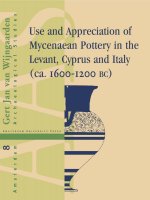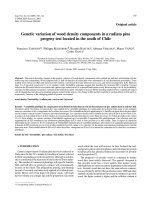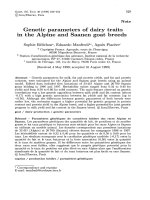Genetic variation of stomatal traits in four tomato hybrids and their parental lines
Bạn đang xem bản rút gọn của tài liệu. Xem và tải ngay bản đầy đủ của tài liệu tại đây (162.28 KB, 6 trang )
Int.J.Curr.Microbiol.App.Sci (2019) 8(1): 1190-1195
International Journal of Current Microbiology and Applied Sciences
ISSN: 2319-7706 Volume 8 Number 01 (2019)
Journal homepage:
Original Research Article
/>
Genetic Variation of Stomatal Traits in Four Tomato Hybrids
and their Parental Lines
Chennem Kiran Kumar Reddy1*, Sudheer Kumar Jain1, M.B. Arun Kumar1,
S. Gopala Krishnan2, Awani Kumar Singh3 and Zakir Hussain4
1
Division of Seed Science & Technology, 2Division of Genetics, 3Centre for Protected
Cultivation and Technology, 4Division of Vegetable Science, Indian Agricultural Research
Institute, New Delhi-110012, India
*Corresponding author
ABSTRACT
Keywords
Tomato, Hybrids,
Parental lines,
Genetic variation,
Stomata
Article Info
Accepted:
10 December 2018
Available Online:
10 January 2019
The present study is an attempt to differentiate tomato hybrids from its parental
lines using stomatal characters like stomatal density, length and width of guard
cells on both the adaxial and abaxial surfaces and to assess the genetic variation
for these traits. Significant differences were found for stomata characters like
stomata density, length, width and area of stomata on both adaxial and abaxial
surfaces of cotyledonary leaf. Hybrids recorded significantly higher stomata
densities than one or both their parental lines. The differences were more
conspicuous on the abaxial surface than adaxial surface. The present study was an
attempt to differentiate hybrid from its parental lines and the hybrid had clear
distinction from one of its parental line
Introduction
Tomato (Solanum lycopersicum L), 2x = 24, a
member of Solanaceae, originated from the
Andean region now consisting parts of Chile,
Bolivia, Ecuador, Columbia and Peru (Sims,
1980). With the revised phylogenetic
classification of the family Solanaceae, the
genus Lycopersicum was re-integrated into
genus
Solanum,
attaining
its
new
nomenclature. Solanum section Lycopersicum
encompasses the cultivated tomato (S.
lycopersicum) along with its wild relatives
(Peralta et al., 2006). Contrast to the rich
reservoir in wild species, cultivated tomatoes
are genetically poor with <5% of genetic
variation of their wild relatives (Miller and
Tanksley, 1990). Besides that tomato being a
predominantly self-pollinated crop tends to
lose its genetic variability even without
selection. One of the avenues given for
improving the productivity is developing and
adopting hybrid tomato cultivation. Hybrids
combine good characters from both the
parental lines and have an advantage over
their parental lines or any other open
1190
Int.J.Curr.Microbiol.App.Sci (2019) 8(1): 1190-1195
pollinated varieties. For conducting genetic
purity testing, a cultivar has to be defined with
its distinguishing characters. Further, India
being a signatory to WTO agreement on
TRIPS, passed the Protection of Plant
Varieties and Farmers Right Act (2001) for
protecting new varieties. The identity of a
cultivar has to be established using
morphological, physiological, biochemical
and molecular characters. Until date,
morphological characters both qualitative and
quantitative form the bulk of varietal
characterization and they have been
universally accepted, as undisputed characters
when used in sequential fashion thus making
them convenient for distinguishing the
different varieties. The narrow genetic base in
the process of evolving new tomato genotypes
makes it difficult to distinguish genotypes
easily. Also, the time taken to observe the
characters over a growing season has
generated interest in searching and utility of
other morphological markers which are
precise in varietal identification. The present
study is aimed to know the genetic variation of
different stomatal and root characters in
hybrids and their parental lines of tomato.
Materials and Methods
A total of four tomato hybrids and their
parental lines (Table 1) developed and
released by Division of Vegetable Science,
ICAR-Indian Agricultural Research Institute,
New Delhi were used in the present study.
For studying the stomatal characters
experiment was conducted on seedlings raised
in plug-trays, in the divisional walk-in-room
germinator maintaining 25°C. Seedlings from
all genotypes were raised in plug trays with
single seedling in each plug for 15 days. Fully
expanded cotyledonary leaves of seedlings,
15-18 days old, were selected for stomata
studies (stage coincided with the emergence of
apical primordial leaf). Epidermal peels of ten
seedlings were obtained from both abaxial and
adaxial surfaces. For deriving the epidermal
peels, the cotyledonary leaf was placed on a
flat surface and covered with a clear
cellophane tape. Gentle pressure was applied
all along the tissue and the tape pulled off
from the leaf by holding the leaf with other
hand. The epidermal peel still adhered to the
tape is mounted as such on to a slide. The
specimen was observed under 10X
magnification of Leica DM750 stereo
microscope. Observations on stomata density
(number per mm2), length (µm), width (µm)
and area (µm2) were recorded.
Pair wise comparisons (between the parental
lines, hybrid with female parental line and
hybrid with male parental line) were made
following ‘t’-test proposed by Cochran and
Cox approximation (Chandel, 1993) for all the
traits.
Results and Discussion
Significant differences were found for stomata
characters like stomata density, length, width
and area of stomata on both adaxial and
abaxial surfaces of cotyledonary leaf (Table 2
and 3).
Stomata density was higher on abaxial surface
than adaxial surface of cotyledonary leaf for
all genotypes under study. PH-1 (15.6), PH-2
(16.7) and PH-4 (16.1) were significantly
different from their respective parental lines.
PH-2 and PH-4 recorded mid-parent values
(intermediate values between the parental
lines), whereas PH-1 was superior to the better
parental line for stomata density. Hybrid PH-8
(16.1) recorded on par stomata density with its
female parental line (16.9), and recorded
significantly higher values than its male
parental line (13.0).
Stomata density on adaxial surface was found
to be significantly different for the hybrids and
1191
Int.J.Curr.Microbiol.App.Sci (2019) 8(1): 1190-1195
their parental lines. For PH-1 (9.1), PH-2
(10.1) and PH-4 (9.3), the values were on par
with their female parental line (9.0, 10.1 and
10.1, respectively) and significantly different
from their corresponding male parental lines
(7.7, 10.8 and 7.7, respectively). PH-8 (10.1)
had stomata density on par with its male
parental line (10.2), and recorded significantly
lower stomata density than its female parental
line (11.4).
Length of stomata on abaxial surface was on
par for two hybrids PH-1 (31.0 µm) and PH-2
(30.7 µm) than their parental lines. PH-4 (30.6
µm) had significantly smaller stomata (guard
cells) length than its male parental line (32.4
µm). PH-8 (29.6 µm) had significantly longer
stomatal guard cells than both of its parental
lines. Length of stomata guard cells on adaxial
surface was observed to be on par with their
respective parental lines in PH-2 (30.7 µm)
and PH-4 (30.4 µm). For PH-1 (30.4 µm), the
difference was significantly greater than its
female parental line (28.8 µm), and on par
with its male parental line (30.5 µm). PH-8
(29.6 µm) recorded significantly higher
stomata length against its male parental line
(28.1 µm), and was on par with its female
parental line (28.9 µm) (Table 2 and 3).
Stomata width on abaxial surface was
observed to be on par with their parental lines
for hybrids PH-1 (21.0 µm) and PH-2 (20.6
µm). PH-4 (21.5 µm) and PH-8 (20.4 µm)
recorded stomata width, which was on par
with their male parental line (20.2 µm and
19.4 µm, respectively). Width of adaxial
stomata was found to be statistically different
from their respective female parental lines for
PH-2 (19.7 µm) and PH-8 (20.2 µm), and on
par with their male parental lines (19.8 µm
and 19.9 µm, respectively). Stomata width
was observed to be on par with both the
parental lines in PH-4 (20.0 µm), and
significantly different from both the parental
lines in PH-1 (19.7 µm) (Table 2 and 3).
Size of stomata on abaxial surface was
statistically higher than both of its parental
lines in PH-8 (606.1 µm2). In PH-1 (649.6
µm2), PH-2 (633.9 µm2) and PH-4 (657.9
µm2), the values observed were on par with
both parental lines. PH-1 (599.2 µm2), PH-2
(608.6 µm2) and PH-4 (609.1 µm2) could not
be distinguished from both of their parental
lines with adaxial surface stomata size
whereas the values were found to be
statistically higher than those to both of
parental lines in PH-8 (599.5 µm2).
Ratio of stomata density on adaxial to abaxial
surface was observed to be statistically
different than those to both of parental lines in
PH-2 (0.61). In PH-1 (0.55), the observations
recorded on ratio of stomata showed that the
hybrid had on par ratio with the male parental
line (0.57), and significantly lower stomata
density ratio against its female parental line
(0.60). PH-8 recorded on par ratio for stomata
density (0.63) in adaxial to abaxial surface
with its female parental line, and significantly
lower ratio with its male parental line (0.80).
PH-4 recorded on par stomata density ratio
(0.58) with both of its parental lines.
Stomata are small pores surrounded by guard
cells (Bosoet al., 2010). They are primarily
engaged in gas exchange and regulation of
water losses. The distribution of stomata
varies from surface to surface of leaves,
position of leaves on the shoot and external
weather conditions. So, the results tend to vary
if genotypes under question are not raised
under similar climatic conditions (Campo et
al., 2004). Therefore, to study the differences
in stomata characters, seedlings were raised in
walk-in-room germinator in the division of
Seed Science and Technology, ICAR-IARI,
New Delhi and samples were taken from 15 to
18-day-old cotyledonary leaf to minimize the
effect
of
environment
on
stomata
development. Significant differences were
observed for stomata density, length, width
1192
Int.J.Curr.Microbiol.App.Sci (2019) 8(1): 1190-1195
and area on both surfaces of cotyledonary leaf
among the genotypes studied. Hybrids
recorded significantly higher stomata densities
than one or both their parental lines. The
differences were more conspicuous on the
abaxial surface than adaxial surface. No clear
relationship was seen regarding the number
and size of stomata. For instance, hybrids in
general having higher stomata density had on
par stomata measurements with parental lines
having lower stomata density (eg: PH-1).
Table.1 Tomato hybrids and their parental lines used in the study
Hybrid
PH-1
PH-2
PH-4
PH-8
Female
Female-1
Female-2
Female-2
Female-3
Male
Male-1
Male-2
Male-1
Male-3
Table.2 Stomata* characters of cotyledonary leaves in tomato hybrids and their parental lines
Genotype
Female-1
PH-1
Male-1
Density
15.1 ± 0.2a
15.6 ± 0.1c
13.6 ± 0.4b
Stomata
Length (µm) Width (µm)
31.4 ± 0.5a
21.1 ± 0.4a
31.0 ± 0.6a
21.0 ± 0.4a
32.4 ± 0.6a
20.2 ± 0.5a
Area (µm2)
660.0 ± 15.8a
649.6 ± 19.1a
678.8 ± 23.4a
Density
19.0 ± 0.5c
16.7 ± 0.1b
14.9 ± 0.3a
Stomata
Length (µm) Width (µm)
30.7 ± 0.6a
19.7 ± 0.4a
30.7 ± 0.8a
20.6 ± 0.5a
29.8 ± 0.6a
19.4 ± 0.4a
Area (µm2)
603.2 ± 22.2a
633.9 ± 23.7a
581.2 ± 21.3a
Density
19.0 ± 0.5c
16.1 ± 0.2b
13.6 ± 0.4a
Stomata
Length (µm) Width (µm)
30.7 ± 0.6a
19.7 ± 0.4a
30.6 ± 0.6a
21.5 ± 0.8b
32.4 ± 0.6b
20.2 ± 0.5ab
Area (µm2)
603.2 ± 22.2a
657.9 ± 22.2a
678.8 ± 23.4a
Density
16.9 ± 0.6a
16.1 ± 0.2a
13.0 ± 0.4b
Stomata
Length (µm) Width (µm)
27.9 ± 0.3b
19.5 ± 0.3a
29.6 ± 0.3a
20.4 ± 0.2b
27.9 ± 0.4b
19.4 ± 0.5ab
Area (µm2)
544.7 ± 11.0a
606.1 ± 8.1b
543.3 ± 20.1a
Genotype
Female-2
PH-2
Male-2
Genotype
Female-2
PH-4
Male-1
Genotype
Female-3
PH-8
Male-3
*Stomata were studied from lower surface (LS) or abaxial surface, where, values are mean values ± standard error,
Values with same letters are statistically on par; and with different letters are significantly different
1193
Int.J.Curr.Microbiol.App.Sci (2019) 8(1): 1190-1195
Table.3 Stomata* characters of cotyledonary leaves in tomato hybrids and their parental lines
Genotype
Female-2
PH-2
Male-2
Density
10.1 ± 0.3a
10.1 ± 0.2a
10.8 ± 0.2ab
Genotype
Female-2
PH-4
Male-1
Genotype
Female-3
PH-8
Male-3
Density
10.1 ± 0.3a
9.3 ± 0.3a
7.7 ± 0.4b
Density
11.4 ± 0.4a
10.1 ± 0.1b
10.2 ± 0.3b
Length (µm)
30.6 ± 0.3a
30.7 ± 0.3a
30.2 ± 0.3a
Stomata
Width (µm) Area (µm2) Density ratio (US/LS)
20.6 ± 0.1a
631.0 ± 7.2a
0.50 ± 0.02a
19.7 ± 0.3b 608.6 ± 11.0a
0.60 ± 0.01b
19.8 ± 0.4ab 597.9 ± 17.6a
0.70 ± 0.02c
Stomata
Width (µm) Area (µm2) Density ratio (US/LS)
20.6 ± 0.1a
631.0 ± 7.2a
0.50 ± 0.02a
20.0 ± 0.5a 609.1 ± 16.7a
0.57 ± 0.02a
20.5 ± 0.2a 626.0 ± 19.6a
0.60 ± 0.03a
Stomata
Length (µm) Width (µm)
Area (µm2)
Density ratio (US/LS)
28.9 ± 0.4a
19.2 ± 0.3a
555.3 ± 11.8a
0.70 ± 0.03a
29.6 ± 0.3a
20.2 ± 0.2b
599.5 ± 9.2b
0.62 ± 0.01a
28.1 ± 0.5ab 19.9 ± 0.3ab 559.5 ± 14.2ac
0.80 ± 0.02b
Length (µm)
30.6 ± 0.3a
30.4 ± 0.3a
30.5 ± 0.8a
* Stomata were studied from upper surface (US) /adaxial surface, where, values are mean values ± standard error,
Values with same letters are statistically on par; and with different letters are significantly different
Wilkinson (1995) reported the stronger
variability for stomata density rather than
stomata index between varieties of a species.
The genetic control of stomata distribution
was reported by Meiselet al (2011), wherein
they proposed specialized vision system
which allows to perceive light signals
initiating biochemical events. This in turn
triggers downstream response. Sugano et al
(2010) also reported an intercellular signal
factor called stomagen produced by
mesophyll cells in Arabidopsis. It interacts
with epidermal cell factors to influence
stomata density.
establishing hybridity as against its
conventional reference for drought screening
is reported (Medrano et al., 2002; Venora and
Calcagno, 1991).
Acknowledgement
Dr. SR Bhat, Principal Scientist(Molecular
Biology), NRCPB for providing the lab
facilities and Dr. DK Yadava, Head, Division
of Seed Science and Technology, ICARIndian Agricultural Research institute, New
Delhi is acknowledged for release of funds.
References
Further, no clear relationship could be seen
between leaf size and stomata density or
stomata size. The present study was an
attempt to differentiate hybrid from its
parental lines provides interesting results as
the hybrid had clear distinction from one of
its parental line (mostly males in the present
study). The utility of this character in
Boso, S., A.V. VillaVerde, J. Santiago, P.
Gago, D.M. Berger, M. Düggelin, H.H.
Kassemeyer and M.C. Martínez. 2010.
Macroand
microscopic
leaf
characteristics
of
six
grapevine
genotypes (Vitisspp.) with different
susceptibilities to grapevine downy
1194
Int.J.Curr.Microbiol.App.Sci (2019) 8(1): 1190-1195
mildew. Vitis. 49, 43-50.
Campo, G.M., P. Baeza, C. Ruiz and J.R.
Lissarrague. 2004. Water-stress induced
physiological changes in leaves of four
container-grown grapevine cultivars
(Vitis vinifera L.). Vitis.43, 99-105.
Chandel S.R.S., 1993. A Handbook of
Agricultural Statistics Achal Prakash
Mandiv, Pandunagar, Kanpur., pp.
A193- A194.
Medrano, H., J.M. Escalona, J. Bota, J. Gulías
and J. Flexas. 2002. Regulation of
photosynthesis of C3 plants in response
to progressive drought: stomatal
conductance as a reference parameter.
Ann. Bot. 89, 895-905.
Meisel, L., D. UrBina and M. Pinto.
2011.Fotorreceptores y respuestas de
plantas a señaleslumínicas (online). In:
F. SQueo, l. CardeMil, (Eds): Fisiología
vegetal. Ediciones Universidad de La
Serena, La Serena. Chile. 18, 1-10.
Miller, J.C. and S.D. Tanksley. 1990. RFLP
analysis of phylogenetic relationships
and genetic variation in the genus
Lycopersicon. Theor. Appl. Genet. 80,
437-448.
Peralta, I.E., S. Knapp and D.M. Spooner.
2006. Nomenclature for wild and
cultivated tomatoes Tomato Genetics
Cooperative Report. 56, 6- 12.
Sims, W.L., 1980. History of tomato
production for industry around the
world. ActaHortic. 100, 25-26.
Sugano, S. S., T. Shimada, Y. Mai, K.
Okawa, A. Tamai, M. Mori and H.
Shimura. 2010. Stomagen positively
regulates
stomatal
density
in
Arabidopsis. Nature. 463, 241-244.
Venora, G., and F. Calcagno. 1991. Study of
stomatal parameters for selection of
drought resistant varieties in Triticum
durum DESF. Euphytica. 57, 275-283.
How to cite this article:
Chennem Kiran Kumar Reddy, Sudheer Kumar Jain, M.B. Arun Kumar, S. Gopala Krishnan,
Awani Kumar Singh and Zakir Hussain. 2019. Genetic Variation of Stomatal Traits in Four
Tomato Hybrids and their Parental Lines. Int.J.Curr.Microbiol.App.Sci. 8(01): 1190-1195.
doi: />
1195









